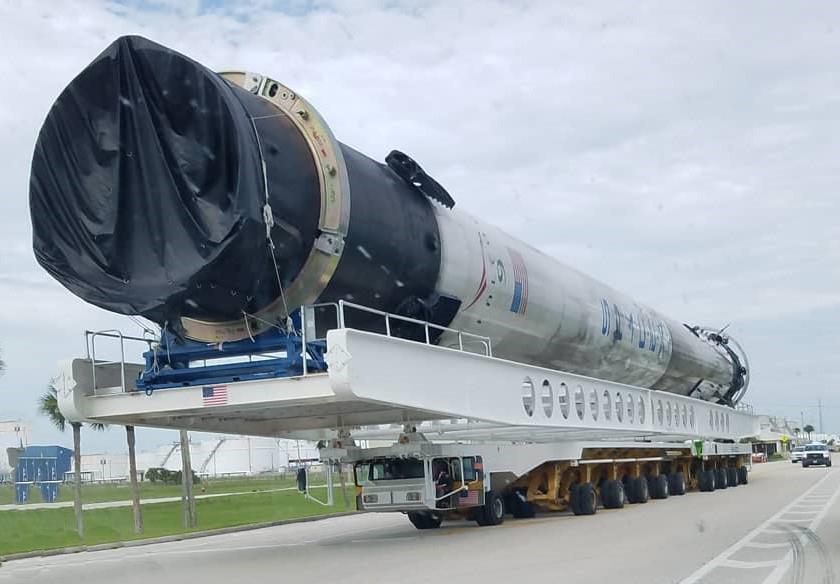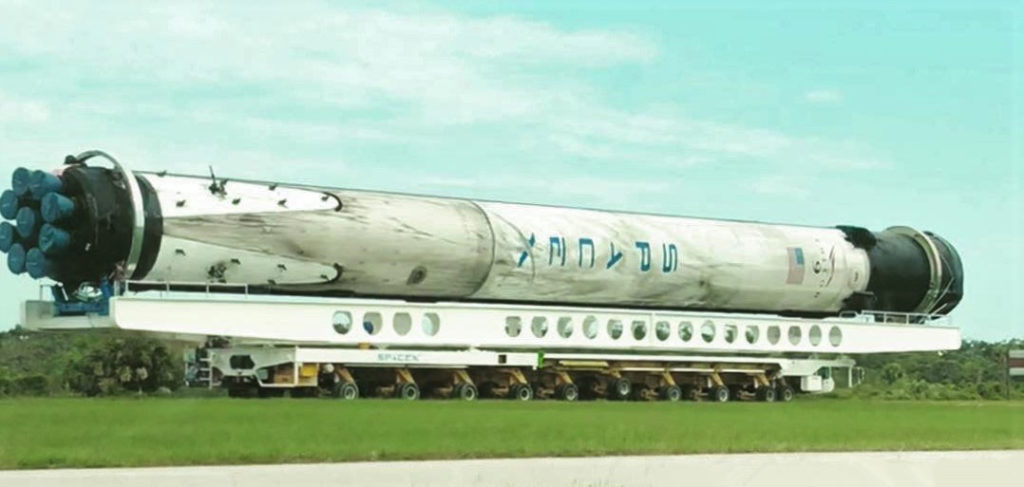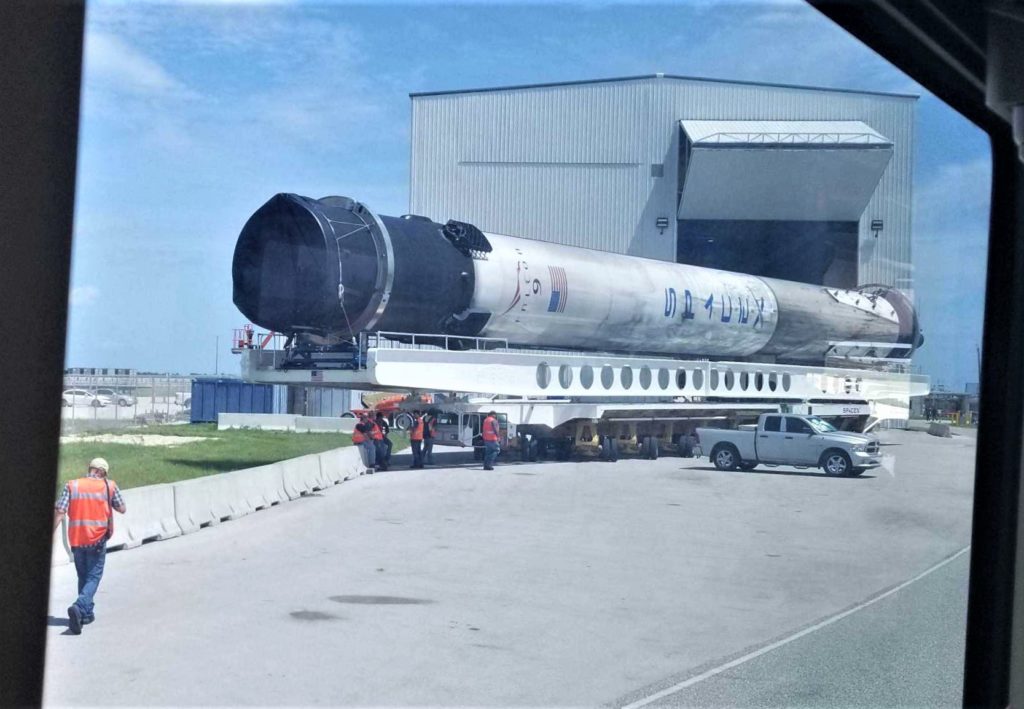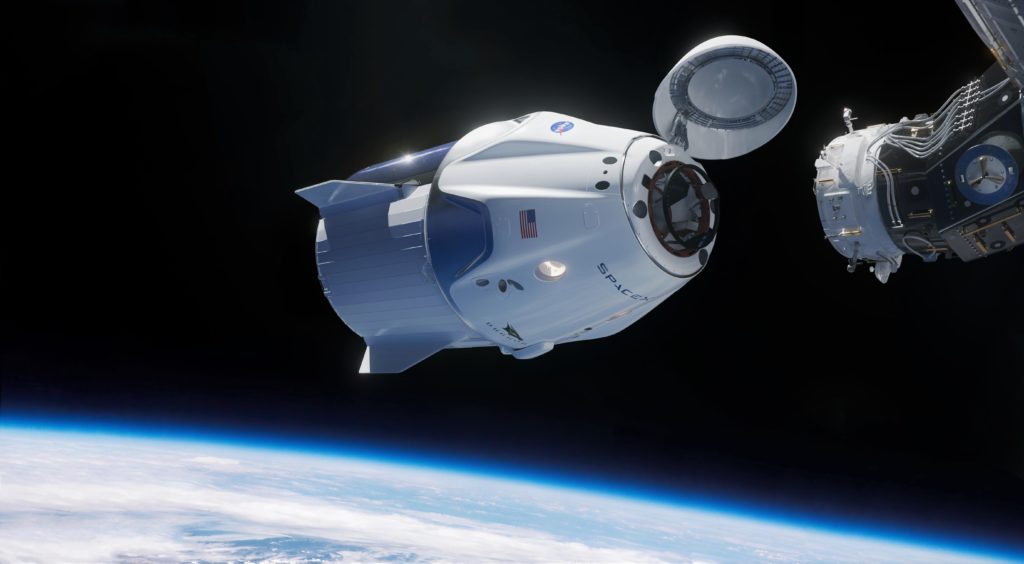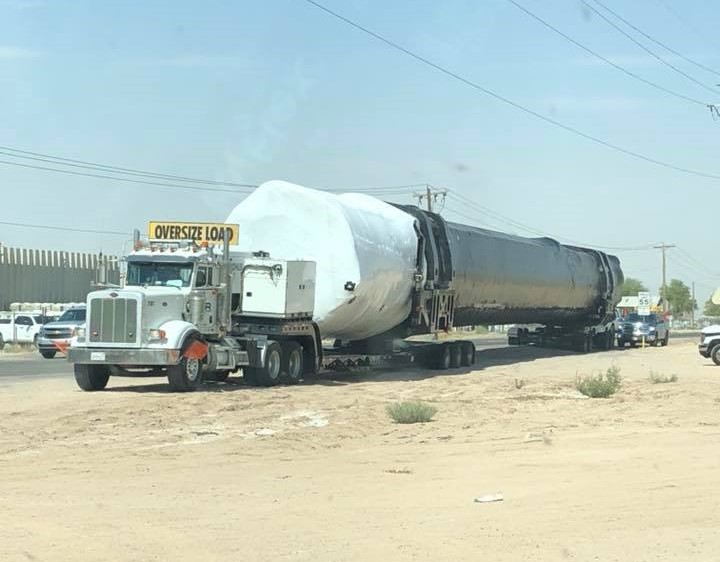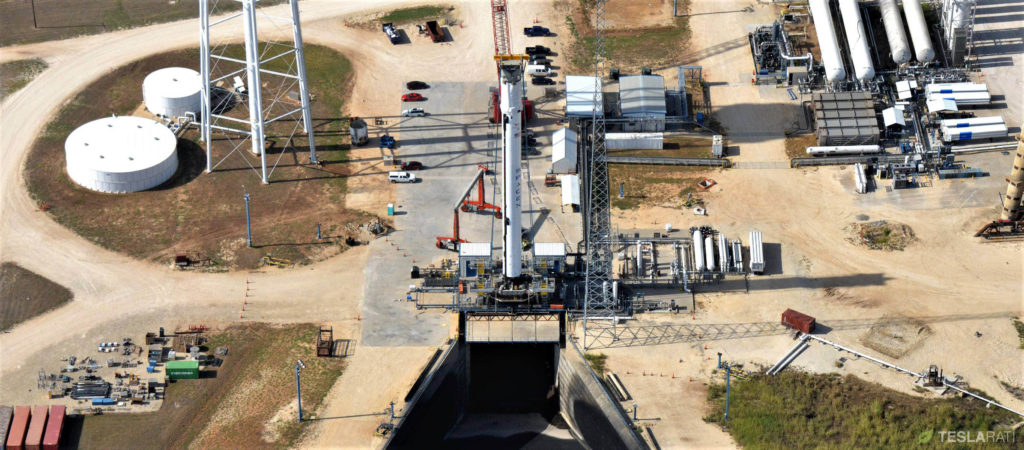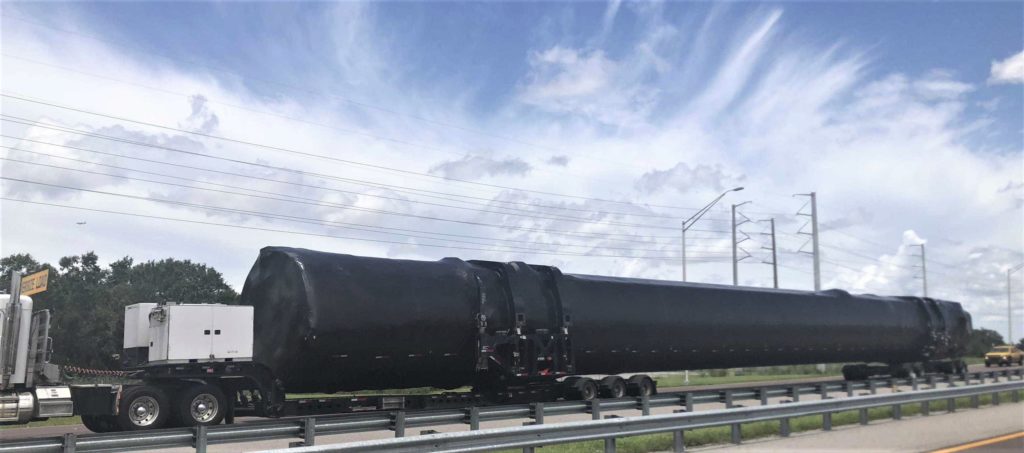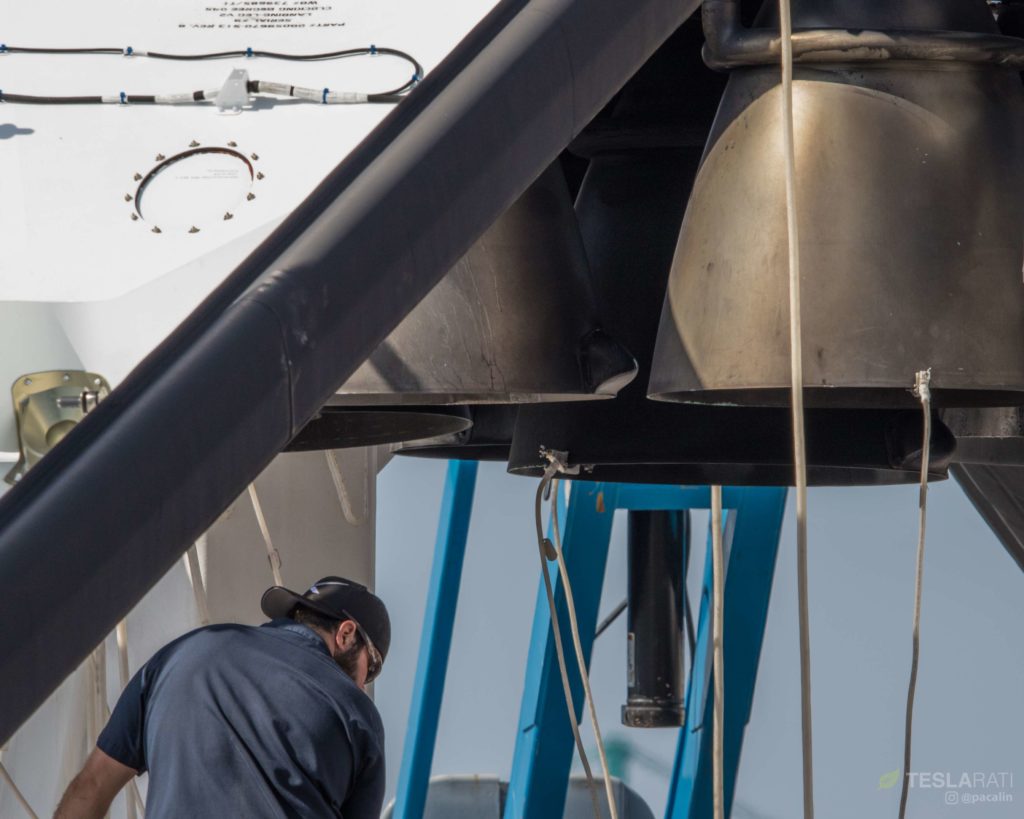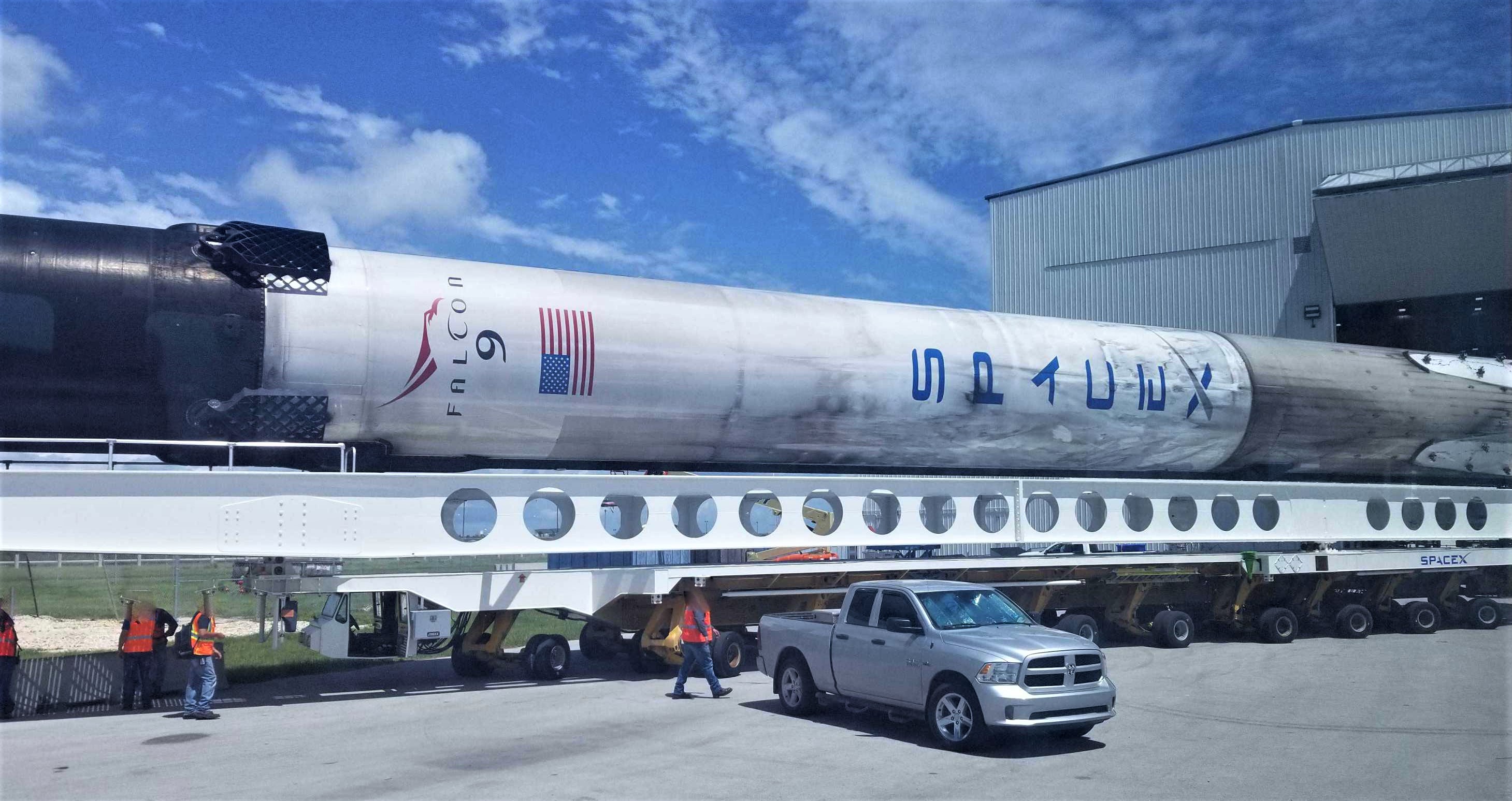

News
SpaceX’s newest Falcon 9 booster arrives in FL as rocket fleet activity rapidly grows
SpaceX’s fifth Falcon 9 Block 5 first stage was spotted a few dozen miles away from arriving at Cape Canaveral at the same time as a freshly launched and landed Block 5 booster was being transported from its drone ship at Port Canaveral to Kennedy Space Center.
The now flight-proven booster in question – B1047 – completed a successful launch of the massive 7100 kg Telstar 19V satellite on July 22nd (EDT), after which it landed safely aboard East Coast drone ship Of Course I Still Love You. Three days after that, sooty Falcon 9 B1047 arrived at Port Canaveral, where it took five days to prepare for transport to one of SpaceX’s several Floridan refurbishment facilities. That transport was captured by an impressive number of independent observers from start to finish, in this case winding up at Pad 39A’s hangar (or horizontal integration facility, HIF) for examination and refurbishment before its next launch.
- B1047 returned safe and sound to Pad 39A for refurbishment less than a week after launching and landing. (Instagram /u/d_lo_ags)
- Likely taken around the same time, Instagram /u/acslater90 took this photo from the opposite direction. (Instagram – acslater90)
- B1047 seen rolling into 39A’s integration hangar for refurbishment on July 31st. (Reddit – Kent767)
Simultaneously, multiple separate members of the subreddit /r/SpaceX observed a different Falcon 9 rocket booster being transported in Western Florida and later Orlando, this time a brand new core shrink-wrapped in the usual black plastic – fresh from static fire testing in McGregor, Texas. A photographer flying in the area in mid-July caught the most likely booster candidate (B1050) vertical on the Texas static fire test stand, rounding out a dizzying array of photos documenting SpaceX’s rigorous test and transport system in action over the last several months.
B1050 will likely be tasked with lifting communications satellite Es’hail-2 in very late August or early September. Intriguingly, the appearance of B1050 in Florida also happens to indicate that SpaceX’s next West Coast launch – SAOCOM 1A, NET September 5th – will have to launch aboard a flight-proven Block 5 booster, of which B1047 and B1048 will be up for consideration. B1051, the next new Block 5 booster expected to ship from Hawthorne to Texas to launch pad, is specifically reserved for SpaceX’s first Crew Dragon mission (DM-1), an uncrewed demo flight that could launch in October or November.
- Crew Dragon gleams in the orbital sunlight before the ISS. The spacecraft’s first launch has reserved Falcon 9 B1051, the next serial booster expected to leave SpaceX’s factory.(SpaceX)
- Falcon 9 B1050 on its way to McGregor for static fire testing, July 6th.
- SpaceX tests all new Falcon 9 boosters and upper stages in Texas before launch. (Aerial Photo/Teslarati)
- Two weeks after it was spotted on the McGregor static fire stand, B1050 rolled into Orlando, FL on July 31st, headed East to Cape Canaveral. (Reddit – alexbrock57)
It’s likely that B1051’s testing and static fire in McGregor will take much longer than the average booster acceptance testing, meaning that the facility’s Falcon 9 booster test capabilities will likely be saturated for a month or longer, pushing B1052’s commercial launch readiness into late September or early October. In reality, B1048 is the only practical option for an early or mid-September launch in California, and that tentative and unofficial booster reflight would crush the current rocket turnaround record by more than four weeks (42 days vs. 72 days).
Booster B1048 just completed its successful debut with the launch of Iridium NEXT-7 and has been under the watchful care of SpaceX recovery technicians since its July 27th return to Port of San Pedro aboard autonomous spaceport drone ship Just Read The Instructions (JRTI). Of particular note, SpaceX technicians took the extraordinary step of opening up B1048’s Merlin engine service bay panels (one per engine along the circumference of the rocket’s base) for several hours on July 30th.
As far as Falcon recoveries go, SpaceX has never been documented performing a similar procedure while the booster is still dockside – perhaps it’s related to the fact that B1050’s East Coast arrival means B1048 will have to be ready for its second launch faster than any SpaceX rocket before it.
- A SpaceX recovery technician works beneath Falcon 9 B1048’s massive octaweb and Merlin 1D engines, July 30. (Pauline Acalin)
- SpaceX technicians examine F9 B1048’s quick-disconnect panel, the interface for much of the vehicle’s fluids and on-pad communications. (Pauline Acalin, 07/30/18)
- A symphony of rocket wrenching, July 30th. (Pauline Acalin)
For prompt updates, on-the-ground perspectives, and unique glimpses of SpaceX’s rocket recovery fleet (including fairing catcher Mr Steven) check out our brand new LaunchPad and LandingZone newsletters!
News
Tesla UK sales see 14% year-over-year rebound in June: SMMT data
The SMMT stated that Tesla sales grew 14% year-over-year to 7,719 units in June 2025.

Tesla’s sales in the United Kingdom rose in June, climbing 14% year-over-year to 7,719 units, as per data from the Society of Motor Manufacturers and Traders (SMMT). The spike in the company’s sales coincided with the first deliveries of the updated Model Y last month.
Model Y deliveries support Tesla’s UK recovery
Tesla’s June performance marked one of its strongest months in the UK so far this year, with new Model Y deliveries contributing significantly to the company’s momentum.
While the SMMT listed Tesla with 7,719 deliveries in June, independent data from New AutoMotive suggested that the electric vehicle maker registered 7,891 units during the month instead. However, year-to-date figures for Tesla remain 2% down compared to 2024, as per a report from Reuters.
While Tesla made a strong showing in June, rivals are also growing. Chinese automaker BYD saw UK sales rise nearly fourfold to 2,498 units, while Ford posted the highest EV growth among major automakers, with a more than fourfold increase in the first half of 2025.
Overall, the UK’s battery electric vehicle (BEV) demand surged 39% to to 47,354 units last month, helping push total new car sales in the UK to 191,316 units, up 6.7% from the same period in 2024.
EV adoption accelerates, but concerns linger
June marked the best month for UK car sales since 2019, though the SMMT cautioned that growth in the electric vehicle sector remains heavily dependent on discounting and support programs. Still, one in four new vehicle buyers in June chose a battery electric vehicle.
SMMT Chief Executive Mike Hawes noted that despite strong BEV demand, sales levels are still below regulatory targets. “Further growth in sales, and the sector will rely on increased and improved charging facilities to boost mainstream electric vehicle adoption,” Hawes stated.
Also taking effect this week was a new US-UK trade deal, which lowers tariffs on UK car exports to the United States from 27.5% to 10%. The agreement could benefit UK-based EV producers aiming to expand across the country.
News
Tesla Model 3 ranks as the safest new car in Europe for 2025, per Euro NCAP tests
Despite being on the market longer than many of its rivals, the Tesla Model 3 continues to set the bar for vehicle safety.

The Tesla Model 3 has been named the safest new car on sale in 2025, according to the latest results from the Euro NCAP. Among 20 newly tested vehicles, the Model 3 emerged at the top of the list, scoring an impressive 359 out of 400 possible points across all major safety categories.
Tesla Model 3’s safety systems
Despite being on the market longer than many of its rivals, the Tesla Model 3 continues to set the bar for vehicle safety. Under Euro NCAP’s stricter 2025 testing protocols, the electric sedan earned 90% for adult occupant protection, 93% for child occupant protection, 89% for pedestrian protection, and 87% for its Safety Assist systems.
The updated Model 3 received particular praise for its advanced driver assistance features, including Tesla’s autonomous emergency braking (AEB) system, which performed well across various test scenarios. Its Intelligent Speed Assistance and child presence detection system were cited as noteworthy features as well, as per a WhatCar report.
Other notable safety features include the Model 3’s pedestrian-friendly pop-up hood and robust crash protection for both front and side collisions. Euro NCAP also highlighted the Model 3’s ability to detect vulnerable road users during complex maneuvers, such as turning across oncoming traffic.
Euro NCAP’s Autopilot caution
While the Model 3’s safety scores were impressive across the board, Euro NCAP did raise concerns about driver expectations of Tesla’s Autopilot system. The organization warned that some owners may overestimate the system’s capabilities, potentially leading to misuse or inattention behind the wheel. Even so, the Model 3 remained the highest-scoring vehicle tested under Euro NCAP’s updated criteria this year.
The Euro NCAP’s concerns are also quite interesting because Tesla’s Full Self-Driving (FSD) Supervised, which is arguably the company’s most robust safety suite, is not allowed for public rollout in Europe yet. FSD Supervised would allow the Model 3 to navigate inner city streets with only minimal human supervision.
Other top scorers included the Volkswagen ID.7, Polestar 3, and Geely EX5, but none matched the Model 3’s total score or consistency across categories. A total of 14 out of 20 newly tested cars earned five stars, while several models, including the Kia EV3, MG ZS, and Renault 5, fell short of the top rating.
Elon Musk
Why Tesla’s Q3 could be one of its biggest quarters in history
Tesla could stand to benefit from the removal of the $7,500 EV tax credit at the end of Q3.

Tesla has gotten off to a slow start in 2025, as the first half of the year has not been one to remember from a delivery perspective.
However, Q3 could end up being one of the best the company has had in history, with the United States potentially being a major contributor to what might reverse a slow start to the year.
Earlier today, the United States’ House of Representatives officially passed President Trump’s “Big Beautiful Bill,” after it made its way through the Senate earlier this week. The bill will head to President Trump, as he looks to sign it before his July 4 deadline.
The Bill will effectively bring closure to the $7,500 EV tax credit, which will end on September 30, 2025. This means, over the next three months in the United States, those who are looking to buy an EV will have their last chance to take advantage of the credit. EVs will then be, for most people, $7,500 more expensive, in essence.
The tax credit is available to any single filer who makes under $150,000 per year, $225,000 a year to a head of household, and $300,000 to couples filing jointly.
Ending the tax credit was expected with the Trump administration, as his policies have leaned significantly toward reliance on fossil fuels, ending what he calls an “EV mandate.” He has used this phrase several times in disagreements with Tesla CEO Elon Musk.
Nevertheless, those who have been on the fence about buying a Tesla, or any EV, for that matter, will have some decisions to make in the next three months. While all companies will stand to benefit from this time crunch, Tesla could be the true winner because of its sheer volume.
If things are done correctly, meaning if Tesla can also offer incentives like 0% APR, special pricing on leasing or financing, or other advantages (like free Red, White, and Blue for a short period of time in celebration of Independence Day), it could see some real volume in sales this quarter.
You can now buy a Tesla in Red, White, and Blue for free until July 14 https://t.co/iAwhaRFOH0
— TESLARATI (@Teslarati) July 3, 2025
Tesla is just a shade under 721,000 deliveries for the year, so it’s on pace for roughly 1.4 million for 2025. This would be a decrease from the 1.8 million cars it delivered in each of the last two years. Traditionally, the second half of the year has produced Tesla’s strongest quarters. Its top three quarters in terms of deliveries are Q4 2024 with 495,570 vehicles, Q4 2023 with 484,507 vehicles, and Q3 2024 with 462,890 vehicles.
-

 Elon Musk4 days ago
Elon Musk4 days agoTesla investors will be shocked by Jim Cramer’s latest assessment
-

 News1 week ago
News1 week agoTesla Robotaxi’s biggest challenge seems to be this one thing
-

 Elon Musk2 weeks ago
Elon Musk2 weeks agoFirst Look at Tesla’s Robotaxi App: features, design, and more
-

 News2 weeks ago
News2 weeks agoSpaceX and Elon Musk share insights on Starship Ship 36’s RUD
-

 News2 weeks ago
News2 weeks agoWatch Tesla’s first driverless public Robotaxi rides in Texas
-

 News1 week ago
News1 week agoWatch the first true Tesla Robotaxi intervention by safety monitor
-

 News2 weeks ago
News2 weeks agoTesla has started rolling out initial round of Robotaxi invites
-

 Elon Musk2 weeks ago
Elon Musk2 weeks agoTesla to launch in India in July with vehicles already arriving: report

